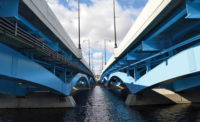Sarah Mildred Long Bridge Replacement
Portsmouth, N.H., and Kittery, Maine
Best Project, Highway/Bridge and Award of Merit, Safety
Owners: Maine Dept. of Transportation; New Hampshire Dept. of Transportation
Lead Design Firms: Hardesty & Hanover; Figg Engineering
General Contractor: Cianbro Corp.
Precast Casting & Erection Engineering: McNary Bergeron
Engineering Support: Structural Technologies
Subcontractors: Case Foundation (Drilled Shaft); Shaw Brothers Construction (Earthwork); Atlantic Coast Dismantling (Demolition); Panatrol (Automation & Controls)
Faced with the challenges of a fast-flowing tidal river in an area prone to harsh weather conditions, the $165.2-million Sarah Mildred Long Bridge replacement project team provided an updated link between Portsmouth, N.H., and Kittery, Maine, with a unique bridge that’s the first of its kind in the U.S. As the existing steel vertical-lift bridge approached the end of its life cycle, the design joint venture of Figg and Hardesty & Hanover, working in conjunction with contractor Cianbro Corp., devised an updated version of the design, incorporating the first use of precast concrete segmental towers on a vertical-lift bridge in the U.S., as well as other concrete elements that could be safely and efficiently fabricated off site.
The 2,800-ft-long replacement bridge carries both vehicular and railroad traffic, so the grade over the new span was limited to what could accommodate trains. Because ships regularly pass underneath on the Piscataqua River, the Maine and New Hampshire departments of transportation stuck with a vertical-lift design that allows larger ships to pass when the span is lifted.
The project impressed ENR’s judges. “It just checks all the boxes in my opinion, and it’s on such a massive scale compared to some of these other projects that are noted, it just overshadows them,” one judge said. “My company actually bid on that project and lost that project, but I still love the way it turned out.”
Concrete Idea
Mike Hawkins, COO for Hardesty & Hanover and project manager on the replacement bridge, says that early on, the team knew it wanted to maximize use of concrete on the bridge. “First and foremost, we found that concrete would help reduce future maintenance needs and extend the lifespan,” he says.
Initially, the team considered using cast-in-place concrete on the towers, but at roughly 60% design, an updated study showed that precast would be more cost effective. For Cianbro and its crews, precast would also make its field work faster, more efficient and safer, resulting in a shortened construction schedule, says Kaven Philbrook, senior project manager at Cianbro.
Philbrook credits much of the team’s ability to find creative solutions for the Sarah Mildred Long Bridge to the owners’ choice of a construction manager/general contractor delivery method. Cianbro was brought on the project in 2012 to help with early design concepts and to provide constructibility and budgetary input. The company was then contracted in 2014 for the construction portion of the work. “It functioned like a design-build procedure, but the designer reports to the owner, not the contractor,” he says.
The bridge consists of a concrete superstructure made up of 500 post-tensioned precast concrete segments resting on concrete piers. The bridge substructure and superstructure are supported by 29 10-ft-dia drilled shafts that extend roughly 60 ft, including a depth of up to 30 ft into bedrock. The steel lift span is supported by four towers made up of 22 post-tensioned precast segments each.
To create the tower foundations, the team designed and installed post-tensioned precast concrete cofferdams. On site, crews lifted the pieces into place using a barge-mounted crane. After installation, the cofferdams were dewatered, then filled with rebar and concrete. All 88 of the tower segments were precast on site.
Offsite Work
Throughout design, the team worked to find additional opportunities where bridge components could be fabricated onshore or by offsite vendors. Components, such as the concrete segmental approaches and the steel twin box-girder lift span, were delivered from offsite fabricators. Structure depths were limited, and girders were provided as smaller field splices to allow them to be shipped to the site by rail, truck or barge.
“We scheduled all deliverables by barge to hit these slack tides. If you missed one, you waited six hours for the next one.”
– Kaven Philbrook, Senior Project Manager, Cianbro
Cianbro says these flexible shipping options opened the bidding process to inland fabricators and ultimately resulted in more competitive steel fabrication bids. Once fabrication of the boxes was completed at inland facilities, individual boxes were trucked to a barge near the site for final fabrication. The 300-ft by 50-ft lift span was erected on a barge to float in place during a channel closure. When fabrication costs were compared, Philbrook says the multi-box girder design provided savings of around $1 million.
The post-tensioned concrete floor and roof slab of the bridge’s control room were also precast, then erected and cantilevered from one of the towers.
Another primary reason for maximizing work off the water was to avoid the challenges of working on the fast-flowing tidal river. With water flows that could reach 4 knots, the river is one of the fastest in the country. Tides could create up to 10 ft of variation in daily surface water levels. “We could only safely move barges on a slack tide, which is a window of a couple hours,” Philbrook says. “We scheduled all deliverables by barge to hit these slack tides. If you missed one, you waited six hours for the next one.”
To further avoid working from barges, Cianbro used a custom-built modular temporary work trestle to provide access to the approaches and tower footings. Philbrook says the team had already successfully used a modular trestle on another bridge project upriver and had it stored in a nearby facility. Portions of that trestle were incorporated into the Sarah Mildred Long Bridge trestle. Use of the trestle to bring concrete and materials directly to the work area greatly improved productivity and safety on the project, he says.
Although construction of the trestle took about 70,000 work hours, Philbrook says it still offered a significant cost savings. “We ran the numbers on barges and found that option was more expensive,” he says. “At the time, the Tappen Zee Bridge project was going and just about every barge around was taken. We saved millions of dollars, mostly in [avoiding] rental of barges.”
Safe Waters
Of the 660,000 work hours on the project, Philbrook says the team’s strategies allowed more than 100,000 to be carried out off the water. Philbrook also notes that its strategies contributed to the team’s exceptional safety record, logging only one recordable injury and zero lost-time accidents. Fabrication carried out onshore or off site offered a more controlled environment, mitigating the potential hazards of working on or over the river. “We’re a 100% employee-owned company, and everyone has a stake in this,” he says. “We all want to do things safer and better.”
The bridge’s design also focused on improving future access on the bridge for maintenance work. The design team devised a unique hybrid tower drive mechanism that locates the main mechanism at the bottom of the tower rather than a more conventional placement at the top of the towers.
“We weren’t necessarily looking for a signature bridge, but I think we got one ...”
– Joyce Taylor, Chief Engineer, Maine DOT
In another innovation, Hardesty & Hanover’s tower pier design included high-density absorbing rubber arch fenders that are directly attached to the bridge tower piers for added protection. The foundations are designed to withstand a 12,000-kip force or vessel load. By eliminating separate fenders, the design maintains the shipping channel width for shipping while reducing the required lift-span length.
A key advantage of the new bridge design is that it creates more clearance for ship traffic. The original bridge featured dual decks with a vehicular deck on top and a railroad deck below. The new bridge also features bi-level approaches, however it incorporates only one movable span with dual seating positions—one at the vehicle level and one at the rail level. Since the rail line only carries traffic twice per year, the span remains almost always at the higher resting position. With an average of 56 ft of vertical clearance in the resting position, the team estimates there will be 68% fewer bridge openings than with the original bridge. The design aims to significantly reduce the number of traffic delays due to stopped traffic on busy Route 1.
While the project finished on time in June 2018, the bridge opened to traffic seven months late. The project team declined to discuss reasons for the delay. After construction was completed, Cianbro sued the Maine and New Hampshire DOTs for more than $16 million, claiming design deficiencies resulted in increased costs and delays, according to press reports. Maine and New Hampshire were expected to pay Cianbro $5 million, according to media reports published in August.
Modern Design
By using mostly concrete, designers were able to give the completed bridge a uniquely modern look. The bridge theme “Sails to Submarines” was chosen to represent the history of the river and submarine construction at nearby Portsmouth Naval Shipyard. The vertical-lift towers were stained with a sweeping curve to represent sails. A sweeping curve was also designed in the concrete shape of the vehicular piers.
The exposed main counterweight sheave at the top of each tower references the sailing aesthetic of a mainsail halyard sheave atop sailboat masts. Local architectural elements inspired by lighthouses as well as textures and proportions drawn from local structures were utilized to articulate the scale of the towers. The team incorporated features of Maine lighthouses in the new bridge’s towers, including thin railing structures.
The bridge was designed with long, open spans, using 11 fewer piers than the old bridge. The new span layout not only enhances vistas for residents and motorists but also enables the new bridge to cross a neighboring Portsmouth street without a pier in the median.
“Our mantra early on was that we wanted a good bridge at a great price,” says Joyce Taylor, chief engineer at Maine DOT. “We weren’t necessarily looking for a signature bridge, but I think we got one—a signature, but a practical one.”
Back to "New England's 2019 Top Regional Work Sets High Standards"








